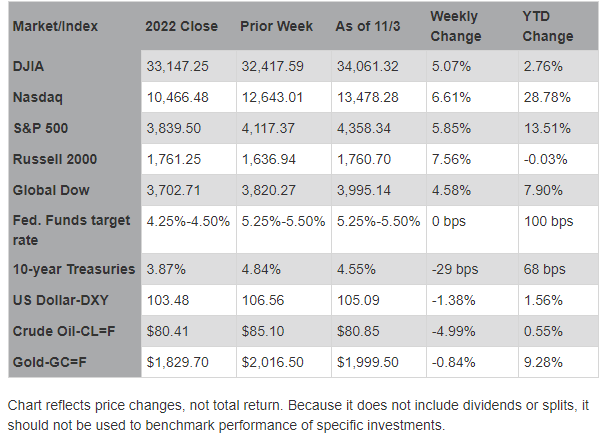Market Week: November 6, 2023
Presented by William Prentice, AWMA®, CFP®, CIMA®
KEY DATES/DATA RELEASES
11/7: International trade in goods and services
11/10: Treasury statement
THE MARKETS (as of market close November 3, 2023)
Wall Street ended a two-week bear run as stocks enjoyed their best week of the year. Each of the benchmark indexes listed here posted solid gains, while bond yields declined, dragged lower by escalating bond prices. Investors may have seen slowing job growth (see below) as more reason for the Federal Reserve to maintain, if not lower, interest rates in the near future. The Fed kept interest rates at their current levels following last week's meeting (see below). Third-quarter corporate earnings have been mixed, with about 49% of the companies of the S&P 500 reporting earnings that are 7.7% above estimates, which is below the five-year average of 8.5% but above the 10-year average of 6.6%. Crude oil prices fell for the second straight week as supply concerns driven by tensions in the Middle East waned. The dollar declined to a six-week low, while gold prices advanced.
Stocks rallied last Monday as investors awaited the outcome of Wednesday's Federal Reserve meeting. The S&P 500 and the Nasdaq, both in correction territory, gained 1.2%. The Dow rose 1.6%, while the Global Dow and the Russell 2000 advanced 0.7% and 0.6%, respectively. Crude oil prices dropped 3.6% to $82.47, as Israel's measured approach to its war in Gaza eased concerns of that other countries, particularly oil-producing nations, would get involved and use oil as a tool of retaliation. Ten-year Treasury yields inched up 3.0 basis points to 4.87%. The dollar fell 0.4%, while gold prices rose 0.4%.
Wall Street continued to trend higher on Tuesday to salvage the final day of October. Investors continued to look ahead to the Fed's interest rate decision on Wednesday and Apple's earnings report on Thursday. The Russell 2000 led the benchmark indexes, gaining 0.9%, followed by the S&P 500 (0.7%), the Nasdaq (0.5%), the Dow (0.4%), and the Global Dow (-0.1%). Ten-year Treasury yields ended the session unchanged from the prior day's value. Crude oil prices fell 1.3% to $81.28 per barrel. The dollar rose 0.5%, while gold prices slipped below $2,000.00 per ounce after declining 0.6%.
Stocks trended higher last Wednesday, helped by a drop in bond yields. The Federal Reserve left interest rates unchanged, as expected. Fed Chair Jerome Powell noted that the surge in bond yields has had a tightening effect on financial conditions. Ten-year Treasury yields fell 8.6 basis points to settle at 4.78%. While each of the S&P 500 market sectors ended the day up, information technology was the best performing, which helped drive the Nasdaq up 1.6%. The S&P 500 gained 1.1%, the Global Dow rose 0.8%, the Dow advanced 0.7%, and the Russell 2000 climbed 0.5%. Crude oil prices slipped 0.2% to $80.90 per barrel. The dollar was unchanged, while gold prices fell 0.4%.
The markets continued to move upward last Thursday as investors may have seen the latest policy announcement from the Federal Reserve as an indication that no more interest rate hikes are likely. Bond prices also advanced, dragging yields on 10-year Treasuries down 12.0 basis points to 4.66%. The Russell 2000 vaulted 2.7%, followed by the S&P 500 and the Global Dow, which advanced 1.9%. The Nasdaq rose 1.8% and the Dow climbed 1.7%. Crude oil prices inched up 0.2%, settling at $82.63 per barrel. Both the dollar and gold prices closed in the red.
Stocks closed higher last Friday, while bond yields fell as recent economic data reinforced the idea that the Fed policy of interest rate hikes may be over. The Russell 2000 capped a banner week after gaining 2.7% for the second straight day. The Nasdaq added 1.4%, the Global Dow advanced 1.1%, the S&P 500 climbed 0.9%, and the Dow increased 0.7%. Ten-year Treasury yields dropped 11.1 basis points to 4.55%. Crude oil prices dipped 1.8%. The dollar lost 1.0%, while gold prices rose 0.3%.
This week is a very slow one for economic data. The trade in goods and services deficit report out this week is for September. The Treasury statement is for October, the first month of fiscal year 2024.
Data sources: Economic: Based on data from U.S. Bureau of Labor Statistics (unemployment, inflation); U.S. Department of Commerce (GDP, corporate profits, retail sales, housing); S&P/Case-Shiller 20-City Composite Index (home prices); Institute for Supply Management (manufacturing/services). Performance: Based on data reported in WSJ Market Data Center (indexes); U.S. Treasury (Treasury yields); U.S. Energy Information Administration/Bloomberg.com Market Data (oil spot price, WTI, Cushing, OK); www.goldprice.org (spot gold/silver); Oanda/FX Street (currency exchange rates).
News items are based on reports from multiple commonly available international news sources (i.e., wire services) and are independently verified when necessary with secondary sources such as government agencies, corporate press releases, or trade organizations. All information is based on sources deemed reliable, but no warranty or guarantee is made as to its accuracy or completeness. Neither the information nor any opinion expressed herein constitutes a solicitation for the purchase or sale of any securities, and should not be relied on as financial advice. Forecasts are based on current conditions, subject to change, and may not come to pass. U.S. Treasury securities are guaranteed by the federal government as to the timely payment of principal and interest. The principal value of Treasury securities and other bonds fluctuates with market conditions. Bonds are subject to inflation, interest-rate, and credit risks. As interest rates rise, bond prices typically fall. A bond sold or redeemed prior to maturity may be subject to loss. Past performance is no guarantee of future results. All investing involves risk, including the potential loss of principal, and there can be no guarantee that any investing strategy will be successful.
The Dow Jones Industrial Average (DJIA) is a price-weighted index composed of 30 widely traded blue-chip U.S. common stocks. The S&P 500 is a market-cap weighted index composed of the common stocks of 500 largest, publicly traded companies in leading industries of the U.S. economy. The NASDAQ Composite Index is a market-value weighted index of all common stocks listed on the NASDAQ stock exchange. The Russell 2000 is a market-cap weighted index composed of 2,000 U.S. small-cap common stocks. The Global Dow is an equally weighted index of 150 widely traded blue-chip common stocks worldwide. The U.S. Dollar Index is a geometrically weighted index of the value of the U.S. dollar relative to six foreign currencies. Market indexes listed are unmanaged and are not available for direct investment.
Prepared by Broadridge Advisor Solutions. © 2023 Broadridge Financial Services, Inc.


